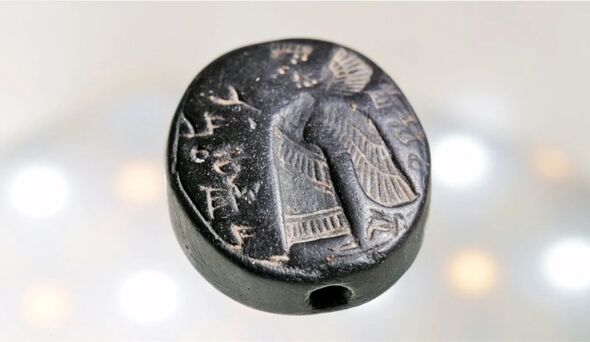Archaeologists in Israel have stumbled upon a rare stone seal from the first temple period – one of the oldest finds since the start of excavations in the country, affirming the biblical role of Jerusalem 2,700 years ago, it has been reported.
The stone was found in the City of David National Park in Israel.
Dr. Yuval Baruch and Navot Rom, excavation directors, said in a press release: “The seal, made of black stone, is one of the most beautiful ever discovered in excavations in ancient Jerusalem, and is executed at the highest artistic level.”
Mr Baruch highlighted the artifact as proof that reading and writing were more widespread during that period than previously believed.
He said: “Contrary to what may be commonly thought, it seems that literacy in this period was not the realm only of society’s elite.
“People knew how to read and write – at least at the basic level – for the needs of commerce.
“The figure of a winged man in a distinct Neo-Assyrian style is unique and very rare in the glyphic styles of the late First Temple period.
“The influence of the Assyrian Empire, which had conquered the entire region, is clearly evident here.”
The seal features a winged genie designed in the Neo-Assyrian Empire style, which the excavation team suggested indicates the empire’s influence in the region during the 7th and 8th centuries.
According to the press release, the figure is depicted with one arm raised and an open palm, possibly holding an object. On either side of the figure, an inscription in paleo-Hebrew script reads, “LeYehoʼezer ben Hoshʼayahu.”
The release continues: “The name Yehoʼezer is familiar to us from the Bible (Chron. I 12:7) in its abbreviated form – Yoʼezer, one of King David’s fighters,” while also stating that “in the book of Jeremiah (43:2), describing the events of this very period, a person is mentioned with a parallel name, ʼAzariah ben Hoshʼaya.
“The two parts of his first name are written in reverse order to the seal owner’s name, and his second name is the same, appearing in its abbreviated form.
“This writing form in the text fits the name on the newly discovered seal and it is thus appropriate for this time period.”
The researchers believe the object was worn as an amulet around the neck of a man who held a senior position in the Kingdom of Judah’s administration.
They based their conclusion on the presence of a hole drilled through the piece, likely to allow it to be worn on a string and the high artistic level required to produce the piece.
Israeli Minister of Heritage Rabbi Amichai Eliyahu praised the piece as a “spectacular and unique find” that “opens another window for us into the days of the Kingdom of Judah … and attests to the administration’s international connections.”
“In doing so, it demonstrates the importance and centrality of Jerusalem already 2700 years ago,” Eliyahu said. “It is impossible not to be moved by such an unmediated and direct encounter with a chapter of our past, a time in which the First Temple stood in all its glory.”
The City of David team will put the seal on public display next week in Jerusalem for two days during the annual research conference, with viewings on Sept. 4 and 5.
